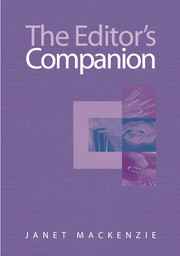Book contents
- Frontmatter
- Contents
- List of illustrations
- Preface
- 1 The editor in context
- 2 The publishing process
- 3 Management and liaison
- 4 Substance and structure
- 5 Language
- 6 Illustrations and tables
- 7 Completeness and consistency
- 8 Proofs
- 9 Editing methods
- 10 Working with documents and files
- 11 Freelance editing
- Appendix: Australian Standards for Editing Practice
- Notes
- Select bibliography
- Index
- Frontmatter
- Contents
- List of illustrations
- Preface
- 1 The editor in context
- 2 The publishing process
- 3 Management and liaison
- 4 Substance and structure
- 5 Language
- 6 Illustrations and tables
- 7 Completeness and consistency
- 8 Proofs
- 9 Editing methods
- 10 Working with documents and files
- 11 Freelance editing
- Appendix: Australian Standards for Editing Practice
- Notes
- Select bibliography
- Index
Summary
The profession of editing for publication is at a crossroads. Either editors go forward to a bright future, with greater status and remuneration than we have ever had; or we slip into oblivion along with other casualties of a rapidly changing world, like Latin teachers and shorthand typists.
Text is being displaced in the dissemination of information–largely because it is often clumsy and ineffective. Editors add value to raw text; we transform information into knowledge. But editorial skills, properly applied, do not draw attention to themselves, and therefore they are overlooked and undervalued. Editing is crucial to the effective presentation of information and the lucid discussion of ideas. The editor knows how to make a product that is functional and fit for its purpose. We conceptualise the kind of publication that will best do the job for the given resources–whether it is a marketing brochure, a website, a textbook or a novel–and we bring it into being.
The emerging national consciousness of the profession is a sign of hope. In 2001 editors nationwide adopted Australian Standards for Editing Practice, which are reproduced in the appendix to this book. The Standards codify the knowledge that editors bring to the job. Admirably succinct, they are statements of principles with wide ramifications that need to be unpacked. The Standards can be regarded as beacons on a rocky shore; The Editor's Companion takes them as its reference points for a detailed chart of the coastline.
- Type
- Chapter
- Information
- The Editor's Companion , pp. xi - xiiPublisher: Cambridge University PressPrint publication year: 2004



